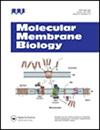溶质载体(SLC)膜转运蛋白的结构生物学。
Q3 Biochemistry, Genetics and Molecular Biology
Molecular Membrane Biology
Pub Date : 2017-02-01
Epub Date: 2018-04-13
DOI:10.1080/09687688.2018.1448123
引用次数: 112
摘要
人类溶质载体(slc)包括400多种不同的转运蛋白,根据其序列同源性和转运功能分为65个家族(http://slc.bioparadigms.org/)。SLCs负责在生物膜上运输各种各样的溶质,包括无机离子、氨基酸、脂类、糖、神经递质和药物。这些膜蛋白大多作为偶联同向转运体(共转运体)发挥作用,利用下坡离子(H+或Na+)梯度作为底物逆浓度梯度转运进入细胞的驱动力。其他成员作为反转运蛋白(交换子),通常包含一个具有交替进入运输模式的单一底物结合位点,而少数成员表现出类似通道的特性。SLCs功能障碍与许多人类疾病相关,因此它们是潜在的治疗药物靶点。在这篇综述中,我们鉴定了所有已经确定的SLC晶体结构,其中大部分来自原核物种。我们进一步将所有SLC结构分为具有不同蛋白质折叠的四个主要组,并进一步讨论了已被充分表征的MFS(主要促进物超家族)和LeuT(亮氨酸转运体)折叠。本文就不同SLC家族成员的结构、底物识别的分子基础和作用机制进行了系统的分析。本文章由计算机程序翻译,如有差异,请以英文原文为准。
Structural biology of solute carrier (SLC) membrane transport proteins.
Abstract The human solute carriers (SLCs) comprise over 400 different transporters, organized into 65 families (http://slc.bioparadigms.org/) based on their sequence homology and transport function. SLCs are responsible for transporting extraordinarily diverse solutes across biological membranes, including inorganic ions, amino acids, lipids, sugars, neurotransmitters and drugs. Most of these membrane proteins function as coupled symporters (co-transporters) utilizing downhill ion (H+ or Na+) gradients as the driving force for the transport of substrate against its concentration gradient into cells. Other members work as antiporters (exchangers) that typically contain a single substrate-binding site with an alternating access mode of transport, while a few members exhibit channel-like properties. Dysfunction of SLCs is correlated with numerous human diseases and therefore they are potential therapeutic drug targets. In this review, we identified all of the SLC crystal structures that have been determined, most of which are from prokaryotic species. We further sorted all the SLC structures into four main groups with different protein folds and further discuss the well-characterized MFS (major facilitator superfamily) and LeuT (leucine transporter) folds. This review provides a systematic analysis of the structure, molecular basis of substrate recognition and mechanism of action in different SLC family members.
求助全文
通过发布文献求助,成功后即可免费获取论文全文。
去求助
来源期刊

Molecular Membrane Biology
生物-生化与分子生物学
CiteScore
4.80
自引率
0.00%
发文量
0
审稿时长
>12 weeks
期刊介绍:
Cessation.
Molecular Membrane Biology provides a forum for high quality research that serves to advance knowledge in molecular aspects of biological membrane structure and function. The journal welcomes submissions of original research papers and reviews in the following areas:
• Membrane receptors and signalling
• Membrane transporters, pores and channels
• Synthesis and structure of membrane proteins
• Membrane translocation and targeting
• Lipid organisation and asymmetry
• Model membranes
• Membrane trafficking
• Cytoskeletal and extracellular membrane interactions
• Cell adhesion and intercellular interactions
• Molecular dynamics and molecular modelling of membranes.
• Antimicrobial peptides.
 求助内容:
求助内容: 应助结果提醒方式:
应助结果提醒方式:


